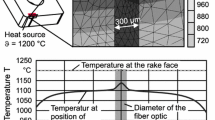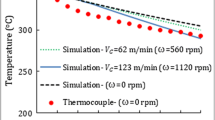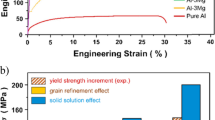Abstract
Aluminum-alloyed ultra-high-carbon steels (UHC-steels) display outstanding mechanical properties combined with a reduced density compared to conventional steels. Consequently, these steels show high potential for industrial applications. A widespread use of UHC-steels containing aluminum depends strongly on efficient machining processes. Since material processing has been restricted to laboratory scale until recently, only few empirical values exist on machining. This paper is focused on the chip formation and tool wear in external turning of aluminum-alloyed UHC-steels. The mechanical loads on the tool are presented and compared to C70MnVS4, which is commonly used for powertrain components. Furthermore, recommendations for optimized cutting tools are given. The results indicate that adhesive wear and chipping are the predominant tool wear mechanisms due to high cutting temperatures and the distinct microstructure of the investigated UHC-steel.








Similar content being viewed by others
References
Oyama T, Sherby OD et al (1984) Application of the divorced eutectoid transformation to the development of fine-grained, spheroidized structures in ultrahigh carbon steels. Scr Metall 18(8):799–804
Sherby OD, Kum DW et al (1988) UHCS containing aluminum, US Patent #4.769.214
Lesuer DR, Syn CK et al (1993) The case for ultrahigh-carbon steels as structural materials. JOM 45:40–46
Taleff EM, Nagao M et al (1996) High-strain-rate superplasticity in ultrahigh-carbon steel containing 10 wt% Al (UHCS-10Al). Scr Mater 34(12):1919–1923
Inden G, Sauthoff G, Grundlegende Untersuchungen zur Darstellbarkeit von Kaltband auf der Basis von Fe-Al-Legierungen. Untersuchungen des Einflusses von Legierungselementen auf die Konstitution—Vorordnungszustände und Defektstrukturen—und die Zähigkeitseigenschaften. In: Drewes EJ, Frommeyer G et al (eds) Höherfester Leichtbauwerkstoff auf der Basis von Eisen-Aluminium-Legierungen. Final report 03 N 3013, 1999
Palm M (1990) Konstitutionsuntersuchungen zum system Fe-Al-C, Dissertation. University Dortmund
Haug T, Kleinekathöfer W, Pol F (2006) Bauteile aus Ultrahochkohlenstoffhaltigen Stählen mit reduzierter Dichte und hoher Zunderbeständigkeit, DE102006041902
Haug T, Kleinekathöfer W et al (2007) Herstellung von superplastischen UHC-Leichtbaustählen und deren Verarbeitung durch Warmumformung, DE102007019980
Haug T, Jung H-P et al (2010) Dichtereduzierter UHC-Leichtbaustahl und dessen Verwendung, DE102010012718
Lipp K, Kaufmann H (2011) Die and powder forging metals for automotive connecting rods. MTZ Worldw eMag 72(5):70–75
Wegst CW (2001) Stahlschlüssel. Verlag Stahlschlüssel Wegst GmbH, Marbach
Furnemont Q, Kempf M, Jacques PJ, Göken M, Delannay F (2002) On the measurement of the nanohardness of the constitutive phases of TRIP-assisted multiphase steels. Mater Sci Eng A328:26–32
Qian L, Li M, Zhou Z, Yang H, Shi X (2005) Comparison of nano-indentation hardness to microhardness. Surf Coat 195:264–271
Nakayama K (1974) The formation of saw-toothed chip in metal cutting. In: Proceedings of the international conference on production engineering Tokyo, vol 1, pp 572–577
Lesuer DR, Syn CK, Sherby OD (1995) Fracture behavior of speroidized hypereutectoid steels. Acta Metall Mater 43(10):3827–3835
Acknowledgments
This work is funded by the Daimler AG. The authors would like to thank the companies Walter and Mapal for providing the cutting tools used in this study.
Author information
Authors and Affiliations
Corresponding author
Rights and permissions
About this article
Cite this article
Denkena, B., Koehler, J. & Dittrich, M.A. Chip formation and tool wear in turning of aluminum-alloyed UHC-steels. Prod. Eng. Res. Devel. 8, 415–421 (2014). https://doi.org/10.1007/s11740-013-0525-8
Received:
Accepted:
Published:
Issue Date:
DOI: https://doi.org/10.1007/s11740-013-0525-8




